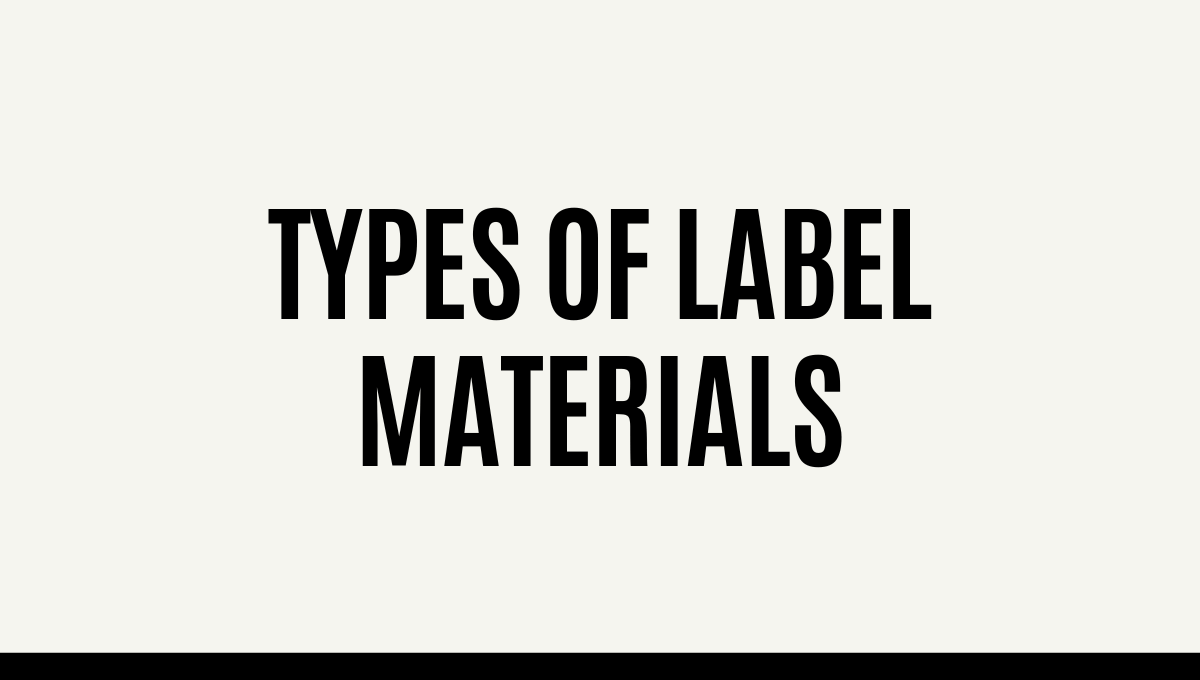Types of Label Materials

Choosing the right label is extremely important. It ensures that you build the right bond with your audience. Many business owners think that paper labels are a good option. The reason for that is because everyone's using them.
But that doesn't mean it's also a good option for your business.
You should know which labeling option is best for your business. It is extremely crucial because every business has different requirements. Even if they are from the same industry, they are still unique. So you should know how to make a perfect label that makes you stand out.
The most important thing in this regard is knowing which material suits your labeling needs. Every material has unique characteristics, features, and qualities.
I'll describe some of the most common materials so you can understand labels. So if you're confused about which material is perfect for your product, read this guide until the end.
Let's get started.
Important Material Components of Labels
There are several types of custom product labels. The material in most labels is almost the same and consists of three major components.
- Facestock: It is the material on which you print
- Adhesive: It is the major component that will make your label stick to the item on which you want to label
- Liner: The adhesive material is applied to the liner
But why should you know about all of this? Is it really important?
Yes.
When you are choosing labels for your business, you also have to pick the perfect liner and strong adhesive. Compromising on these means compromising on the quality of your labels. Different types of adhesives can easily adhere to plastics, cardboard, etc.
But what if your material is metal, but adhesive can't adhere to it?
It'll be a huge problem.
Because all the time and money will go in vain, most label materials have extremely strong adhesives that can easily stick to standard packaging surfaces. The type of surface is also important in choosing a suitable material for your labels.
Common Label Materials
If I say there are just five types of label materials, then that would be completely wrong because there are several types of materials and subdivisions in them. But I'll tell you some of the most common types of label materials you can choose from.
Paper Labels
Due to their versatility, paper label materials are an excellent choice for various products and industries. They are cost-effective and have a wide range of customization options. Paper labels are categorized based on different features as below.
White Gloss Paper
If you want glowing and shiny labels, then try white gloss paper. They are available in vibrant colors, and the best part is they are inexpensive. Just imagine a product with a white gloss paper label on the shelf. It's enough to turn the heads of your customers.
Looking for a glossy finish? White gloss paper is an ideal choice for you.
Why Choose It: Vibrant, eye-catching vivid colors. Reflective properties add depth.
White Semi-Gloss Paper
It is best for indoor applications. It'll provide a crisp and clean polishing, thus converting simple, boring labels into works of art. You should know that the variety of colors is not so vibrant, especially in comparison to white gloss stock.
It's suitable for usually handled labels and it doesn't get smudges or dirt quickly. Shipping labels are one of the most important applications of this.
Why Choose It: Crisp and clear printing. Resistant to smudging and fingerprints.
Brown Kraft Paper
Have you seen a Kraft paper bag? It gives a minimalistic look that looks trendy. This is an eco-friendly option, sustainable, and gives an aesthetic vibe.
The major reason why people prefer it is because it's 100% recycled and natural. Due to its textured finish, it's used in a variety of applications. But they are not water resistant.
Why Choose It: It has rustic and artisanal appeal. The tactile texture adds warmth.
Uncoated White Paper
It's the basic version of paper labels; you can use it for almost anything. But don't use it for packages containing liquid or oil.
Why Choose It: A natural and clean aesthetic.
BOPP
BOPP stands for "Biaxially Oriented Polypropylene." It's a plastic film commonly used for packaging and labeling due to its transparency, strength, and moisture resistance.
It's often used for items like snack packaging, adhesive tapes, labels, and more.
White Bopp
They are also known as film labels or even plastic labels because they're made from Biaxially oriented polypropylene.
You might wonder why they're so popular.
The secret is that BOPP labels are created by stretching the material in two different directions. This special stretching makes the labels super strong and almost impossible to tear. They're like the Hulk of labels.
Why Choose it: Tough & tear-resistant and handles moisture well. It is clear & transparent.
Silver Bopp
Silver BOPP labels offer a dual advantage of durability and elegance. They make your labels look super fancy and catch people's attention on the store shelf.
Why Choose It: Lustrous & sophisticated and resistant to oil, they maintain elegance despite wear.
Films
Films are typically made from various types of plastic materials. They are of different types.
Polypropylene
If you have a product or application resistant to water, oil, and various types of chemicals. Then choose polypropylene. This type of film material has high transparency, giving a neat, no-label look.
That's why it's widely used for beverages and beauty items.
Why Choose It: High transparency for a clean, modern label look. Tear resistance for durability.
Polyethylene (PE)
It is quite similar to Polypropylene and is resistant to oil and chemicals. But its good contouring and flexibility make it a perfect choice for highly squeezable flexible packaging. They are often used in the health, beauty, and home care labeling industries.
Why Choose It: Soft texture enhances the user experience. Low environmental impact with recycled labels.
Polyester
These films have excellent clarity, resistance, and durability. It is resistant to moisture and extreme temperatures. It is often confused with stainless steel.
If you have a product that is temperature resistant or sensitive to moist environments that can even alter the physical properties of the product, then polyester is a popular choice for your needs.
Why Choose It: Abrasion resistance for long-lasting clarity. Maintains shape and dimensions over time.
Squeezable Film
These flexible films are the best if you're worried about peeling and wrinkling on shaped containers. These are widely used in squeezable applications.
One of the best applications where squeezable films are used is your toothpaste. Other than that, it's also used in CBD balms and squeezable tubes.
Why Choose It: Offers tamper-evident seal for security. Maintains label quality after repeated squeezing.
Special Types Of Labels
I've shared some of the most common label materials with you. But there are still more which I'll share now.
- Matte Paper: It is exceptional for making your labels nice and super high-quality. They are resistant to fingerprints and glare-free. If you have an amazing design, the clean surface of this paper will provide the best results.
- Fluorescent Paper: It'll help your labels pop out with vibrant colors. Best for promotional offers.
- Silver Metallic: Want a polished look for your high-quality labels? Use silver material, which is available in matte and gloss finish so that you can choose one according to your requirements.
- Rubber: You can use it for backing tapes and films. It's inherently waterproof, freezer-safe, gas-impermeable, and functional across diverse temperature ranges.
What Kind Of Label Is Best For You?
After understanding the material options for the labels, you should get clarity on what kind of labels you want.
Let me elaborate on it more for you.
Firstly you should know which color and finish is suitable for your labels. Such as, if you have a vibrant, youthful product like energy drinks, a bold and bright color palette with unique fonts will go well with it. So when your product is on the store shelves, it'll attract customers' attention.
Next is, deciding whether the product container has a solid or clear color. Usually, if the product container is clear, the label is full of vibrant colors, while for solid-colored containers, a contrasting label color scheme is used.
Remember to choose a color palette that complements the container and can create a striking visual impact.
Decide what will be the shape and size of your labels.
If your product has a unique, custom shape, then die-cut labels are a good option. If your products are exposed to harsh chemicals, weather conditions, or water/oil, choose special custom labels that are chemical resistant, durable, waterproof, withstand harsh weather conditions, oil resistant, and have specific features that make them withstand these harsh conditions.
Your label quality should not deteriorate when it comes in contact with water. In a nutshell, you should know at least five things before choosing label material.
- Color of your container
- The shape of your product
- Temperature and environmental conditions
- Application surface
- Method or approach of application
You can create better labels for your business by getting clarity on these basic things. In simple words, the more you know about your label, the better.
Conclusion
You might want oil-resistant, waterproof material, transparent, or any other type of label. But don't forget to ensure that it matches your business's aesthetic. I've listed some of the most important things you should consider while choosing material for your product labels.
But despite reading all that, you might face difficulty implementing it practically. After all, the application process is not easy.
That's where Altro Labels come to rescue you. We provide unique label services to businesses that want to level up their business.
We take great pride in providing exceptional quality that makes our customers happy with the results. You don't have to worry while working with us because you'll get high-quality, attractive, attention-grabbing, and beautiful labels.
No matter which industry you're working in, either food, beverage, clothing, restaurant, shopping, or any industry, contact us today to get superior label designs with quick turnaround times.
So what are you waiting for? Contact us today.
